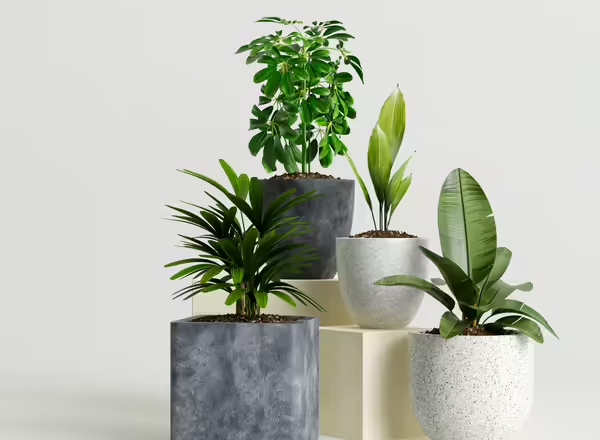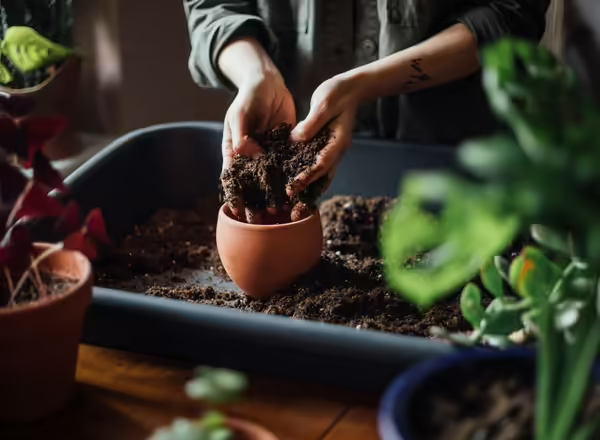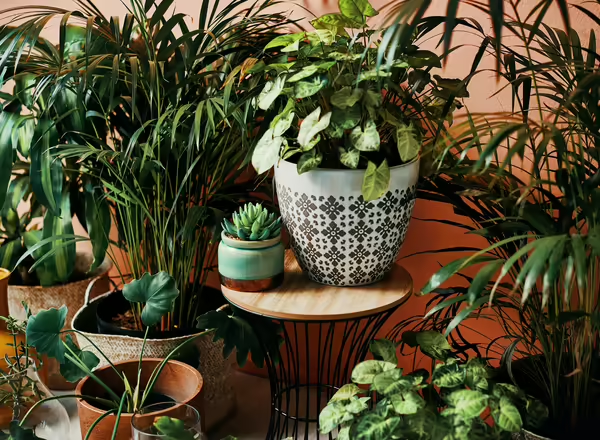
Size: The right pot size is important. Do not over-pot by placing a small plant into a large pot, because the soil will remain too wet for too long. Poor growth or root rot may result. Instead, move up one pot size. This means selecting a container that is 1-2 inches larger in diameter.
Drainage: When choosing containers, make sure there is adequate drainage. Containers with drainage holes are the best for most plants. Plants grown in pots without drainage holes pose a greater risk of developing root rot and other disorders associated with poorly drained or waterlogged soil.

Potting Mixes: When re-potting a houseplant, use disease and pest free potting mixes. Houseplants will perform best in a sterilized mix that provides good drainage. Many choices are available. Generally, a mixture of 1/3 soil, 1/3 peat moss, and 1/3 perlite or vermiculite works well for most houseplants. Some plants require a very specific soil type and should be matched accordingly.
Soil-less Mixtures: These mixes contain organic materials, such as peat moss and perlite and ground bark, but no soil. Since there is very little nutritional value in these mixes, proper fertilizing is important.
Garden Soil: Using soil from your garden is not recommended, unless it has been sterilized and also amended with peat moss, perlite or vermiculite to improve the drainage. Garden soil alone will not provide adequate drainage in a pot. Also, it harbors disease and insect organisms.

What to look for: Houseplants are sold in many different places, such as at florists, greenhouses, nurseries, home improvement centers, craft fairs, flea markets, and even out of a truck in a parking lot. Plant quality and guarantees, along with price are important factors to consider when making a purchase.
Quality: There are several things to look for when shopping for a healthy plant.
- Begin by inspecting the leaves carefully. They should have the right color, shape, and size and be free of blemishes or brown edges. Also, the lower leaves should not be pale or yellow.
- A good specimen should not look leggy or sparse. It should have a good, balanced shape and not be top heavy.
- Look closely at stems and leaves for any signs of insects or disease.
- Finally, look at the pot and soil. If roots are growing through the drainage holes or are seen at the soil surface, the plant has probably outgrown its pot. If you choose this plant, special care will be needed when transplanting into a larger pot.

It is a good idea to keep a new plant away from other plants for 2-3 weeks. This will protect the other plants from possible attack by any insects or disease you might have missed.
Most houseplants are tropical or sub-tropical in origin. Often, they have been grown in greenhouse conditions or even outdoors in southern climates. If plants have not been acclimatized, they may go through a period of shock.
Often, plants drop some leaves or some leaves may yellow, when first brought into a new environment. This adjustment period should not last more than a few weeks. During this time, keep the plant relatively cool to help minimize water loss through its leaves. Check the soil regularly to determine when to water. Also, do not fertilize at this time, since the plant is adjusting to lower light and humidity conditions.